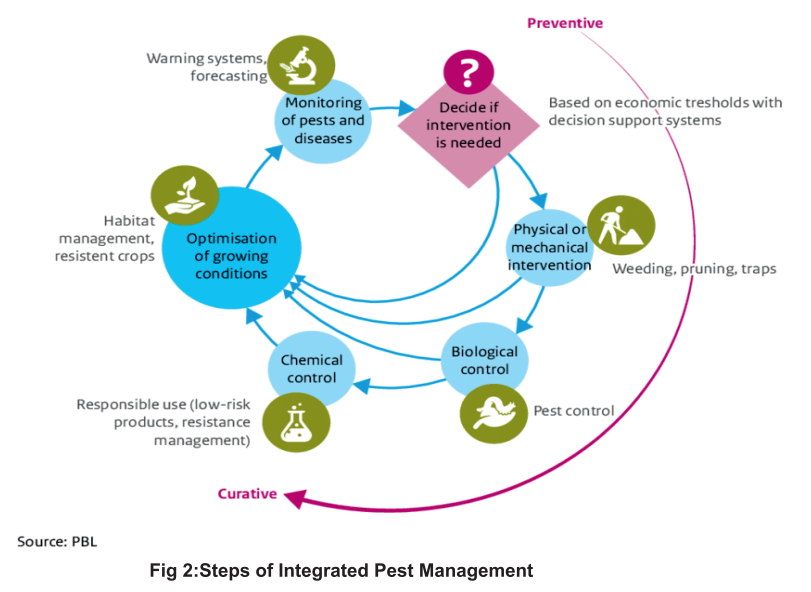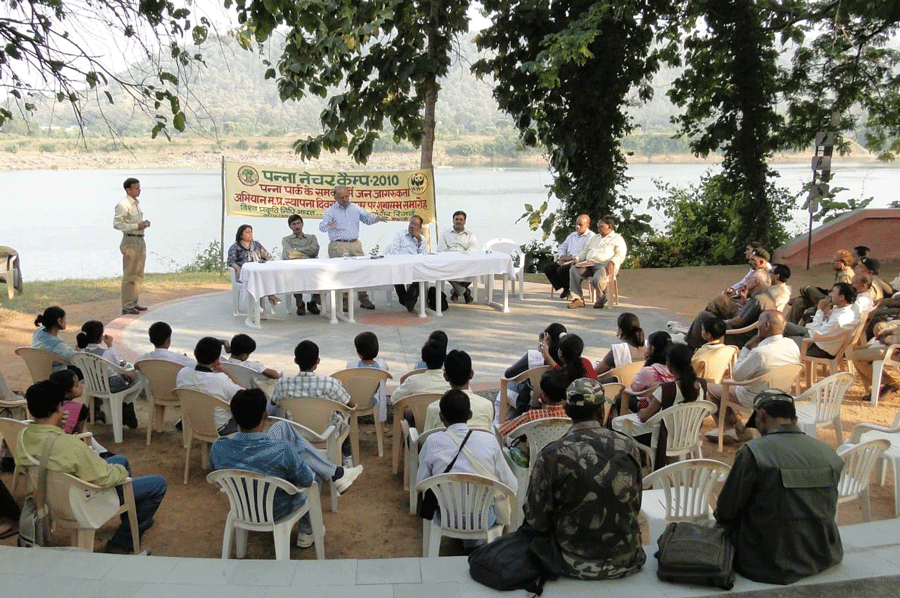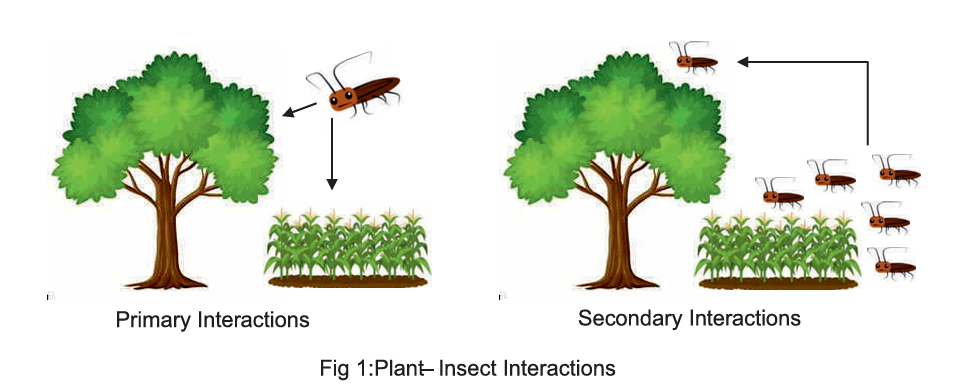Introduction to Agroforestry: A sustainable approach to pest management
Introduction
Agroforestry is a traditional land-use practice that integrates trees and shrubs into agricultural landscapes. The intensification of agriculture has led to a shift from polycultural systems to spatial and temporal monocultures. This transformation has caused significant biodiversity loss due to the destruction of forests and extensive monoculture practices. High-yielding crop varieties have introduced genetic uniformity, exacerbating pest problems. For example, cotton crops suffered extensive damage from pests like Heliothisarmigera and Bemisiatabaci with the introduction of high-yielding varieties and expanded cotton cultivation (Sundaramurthy, 1992a). Currently, there is a growing emphasis on sustainable pest and herbage management. Over the past decade, agroforestry has gained recognition as an eco-friendly management practice, especially beneficial for smallholder farmers. This approach addresses soil erosion and declining soil fertility issues while providing fodder and fuelwood. Additionally, agroforestry offers multiple outputs, including animal, crop, and tree products, contributing to a more resilient and sustainable agricultural system.
Pest Status in Agroforestry
Diversified ecosystems tend to have lower pest populations compared to monoculture systems. While the insect fauna present on a crop or tree species may be similar regardless of whether they are grown in monoculture or polyculture, the intensity of pest infestations can differ. Monocultural fields are more easily detected and colonized by pests, whereas plant diversity in polycultures results in fewer potential hosts for any given pest, leading to reduced overall colonization of crops.
In agroforestry systems, plant-insect interactions can be categorized as primary or secondary. Primary interactions occur when tree and crop species share pests or their natural enemies. Secondary interactions happen when one plant species affects the survival and growth of pests and their natural enemies on another plant species. (refer to fig 1) For example, pests such as cutworms, white grubs, termites, grasshoppers, and crickets have been reported to feed on multiple tree and crop species.
Positive Interactions in Agroforestry
- Physical and Chemical Barriers: Trees can serve as physical or chemical barriers against pests. For example, maize in a maize/apple agroforestry system saw reduced attacks from Macrodactylis sp. (Altieri et al., 1987).
- Attracting Predators and Parasites: Intercropping attracts more predators and parasites compared to monoculture. In China, intercropping rice with pond cypress trees increased spider populations in rice fields, reducing brown plant hopper numbers
- Niche Diversity and Complexity: Agroforestry systems have greater niche diversity and complexity than monocultures, leading to fewer pest problems (Stamp et al., 1998;)
Several mechanisms contribute to this:
- Variable Host Plant Distribution: Pests find it harder to locate host plants.
- Trap Crops: Highly attractive plants act as ‘trap-crops, protecting economically valuable species.
- Repellent Plants: Certain plants repel pests, deterring them from other nearby plants.
- Natural Enemies: Higher plant diversity boosts predator and parasitoid populations, increasing natural pest control.
- Interspecific Competition: Competition between pest and non-pest species limits pest spread.
- Enhanced Pest Regulation: Agroforestry can be managed to enhance pest regulation by providing food sources for parasitoids and sites for mating and resting (Stamp et al., 1998). Structural and Microclimatic Diversity: Trees contribute to structural and microclimatic diversity, providing alternate food sources and stable refuges for beneficial organisms. This is particularly valuable after crop harvest when pest populations are naturally reduced (Schmidt and Tscharntke, 2005).
Negative Interactions in Agroforestry
- Microclimate Alteration: The presence of woody components in agroforestry systems changes the microclimate, including temperature, relative humidity, and solar radiation interception. These changes can directly influence pest intensity, particularly sucking pests.
- Year-Round Shelter and Food Sources: Trees provide shelter and alternative food sources throughout the year, which can sometimes increase pest problems. For example, in Jhansi, India, Acacia tortilis trees used as border plantings led to increased blister beetle damage on accompanying pulse crops. This was due to the synchronization of flowering, with beetles feeding on both the trees and crops (Shanker, 1999).
Integrated Pest Management in Agroforestry
A well-designed agroforestry system with carefully selected components can deter pests and promote natural enemies. Here are several strategies for effective pest management in agroforestry (refer to fig 2)
- Cultural Control/Management Practices: Selecting tree and crop components that do not belong to the same botanical taxa helps maintain pest balance and avoid cross-infestation. For instance, Leucaena planted as a hedge with maize, cassava, and upland rice exhibited reduced psyllid damage (Parera, 1998).
- Resistant Varieties: Growing pest- and disease-resistant varieties within an agroforestry system can significantly reduce pest loads. However, breeding trees for pest resistance remains an under-researched area.
- Mechanical Control: Trees often serve as shelters for adult pests. Mechanically collecting pests can significantly reduce their numbers and the cost of insecticides. For example, the mechanical collection of white grub adults from Prosopis specigera trees was found to be both cheap and effective in a pearl millet cropping system, compared to soil-applied insecticides (Kumawat and Yadava, 1990).
- Physical Control: Various traps are used by entomologists and pest managers to monitor and mass-trap adult pests. Yellow sticky traps effectively catch weak-flying adults of sucking pests, such as aphids and whiteflies. Light traps can mass-trap Calopeplaleayana, a defoliating beetle of Gmelina arborea, which is highly attracted to white light.
- Semiochemicals/Phe romones: These insect behavior-modifying chemicals are identified, isolated, and commercially produced for many forest and crop pests. Pheromone traps help monitor and trap pests like Heliothisarmigera, which infest both trees and crops. Semiochemicals also attract predators and parasitoids of pests (Ananthakrishnan, 1995).
- Biological Control: Natural enemies are most successful in stable forest ecosystems, keeping over 90% of arthropod herbivore populations below outbreak levels. Agroforestry, resembling a stable natural ecosystem, can augment and conserve these natural enemies. For example, the parasitization of the gram pod borer, Heliothisarmigera, by the hymenopteran parasitoidCampolitischloridea was higher when grown with bamboo (Dendrocalamusstrictus) (Chitra, 1997).

Conclusion and Future Directions
Agroforestry presents a sustainable and eco-friendly approach to pest management by integrating various strategies to control pests and enhance biodiversity. Effective pest management in agroforestry systems involves a combination of cultural, mechanical, physical, and biological controls, as well as the use of semiochemicals and botanical pesticides.
Agroforestry presents a sustainable and eco-friendly approach to pest management by integrating various strategies to control pests and enhance biodiversity. Effective pest management in agroforestry systems involves a combination of cultural, mechanical, physical, and biological controls, as well as the use of semiochemicals and botanical pesticides.












